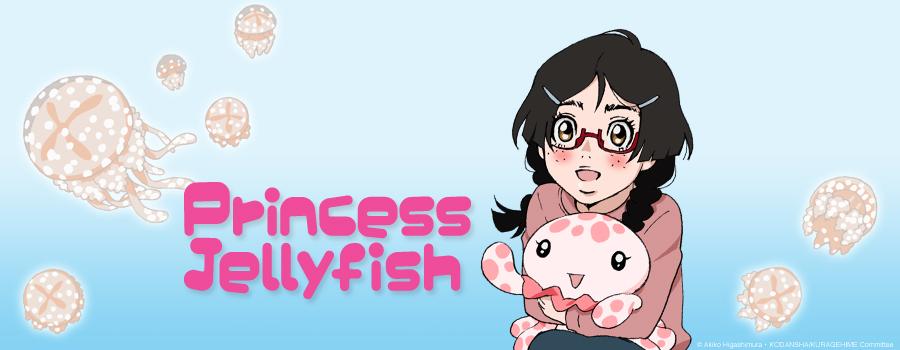Princess Jellyfish (TV)
Go back to Princess Jellyfish main page
The opening parodies Star Wars, Singing in the Rain, Mary Popins, James Bond, Kill Bill and many others
In episode 1 at about 10:53, the touching scene between Tsukimi and Kurara is a parody of a similar scene in episode 51 of the 1974 anime “Alps no Shoujo Heidi” (Alps' Girl Heidi). In that anime, Heidi gets really emotional when her best friend Clara Sesemann finally manages to walk on her feet after being wheelchair bound for so long.
In episode 3, Mayaya's explanation in respond to Kuranosuke's question whether they are involved in any form of employment or education is a parody of NHK Project X ~Challengers~. In fact, the background tune playing to her explanation is Chijou no Hoshi (地上の星), the theme for Project X ~Challengers~; the captions fading in and out is also a style used prominently in Project X ~Challengers~.
In episode 5, the scene that starts at about 19:15 when Tsukimi is peeking into the room where Mayaya is being dressed up by Kuranosuke is a parody of the old Japanese folklore tale “Tsuru no Ongaeshi” (鶴 の 恩返し) or “The Crane's Favour Requital”. More information about the tale can be found at "http://web-japan.org/kidsweb/folk/tsuru/index.html"
In episode 5 around 2:00, Tsukimi's flashback was made to look like a trailer, complete with Fuji TV, Toho Company, Asmik Ace Entertainment, and 東村プロ (Higashimura Pro) cards.
In episode 6, at about 7:40, Kuranosuke was referring to the famous Buddha statues carved in the rocky cliffs facing the city of Bamyan in central Afghanistan. He also refers to the Buddha statues that appear in the "Kasa Jizou" (笠 地蔵) folklore tale. More information about the tale can be found at "http://web-japan.org/kidsweb/folk/kasajizo/index.html"
In episode 7, the title is a pun on the Japanese film "Kin'yuu Fushoku Rettou: Jubaku "金融腐蝕列島:呪縛. Though never released in America, its English title was "Jubaku: Spellbound." This is why Funimation chose to not provide a literal translation of the title, but instead make it a pun on the (non-literal) English title.
In episode 7, at about 17:49, Kuranosuke describes Tsukimi as a Mizuki Shigeru character because she looked like the character Kitarou from the manga “Ge Ge Ge no Kitarou” (ゲゲゲ の 鬼太郎) created by the famous mangaka Mizuki Shigeru (水木 しげる) while she was sipping her tea.
In episode 10, at about 19:34, Jiji was referring to the 1981 Japanese TV drama series “Kita no Kuni kara” (北 の 国 から) or “From the Northern Country” which tells the story of the trials and tribulations of the Kuroita family in Hokkaido (hence the name). Jiji is probably a fan of Tanaka Kunie (田中 邦衛) who plays the role of Kuroita Goro; the father of the Kuroita family in the series
In episode 11, the scene between Kuranosuke and Tsukimi that starts at about 8:05 is a parody of the 1956 Japanese movie “Biruma no Tategoto” (ビルマ の 竪琴) or “The Burmese Harp”. The movie is about the events experienced by the Japanese soldier Private Mizushima and his group in Burma during the final days of World War II. The scene includes various elements that appear in the film like the harp that private Mizushima used to play, the parrot used to convey the message “Mizushima, let's go back to Japan together” to private Mizushima, Private Mizushima dressed up as a Buddhist monk, Captain Inoue repeating the phrase that was taught to the parrot and the Shwedagon Pagoda in the background to symbolise Burma.
| You can contribute information to this page, but first you must login or register |
| DISCLAIMER | add information | report an error | lookup sources |

